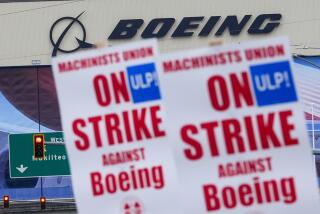Thornton Wilson; Boeing Chief Cut Costs, Created Economy Jets
- Share via
Thornton A. Wilson, the former chairman and CEO of Boeing whose radical cost-cutting kept the aircraft company afloat amid the gas shortage and deregulation of the 1970s, died in his sleep at his Palm Springs home and was found by family members Saturday morning.
He was 78 and was credited with developing the fuel-efficient Boeing 757 and 767, the aircraft that helped the company dominate the commercial jetliner market.
Wilson took over Boeing as president in 1968 when it was near collapse and administered bitter medicine to keep it alive: He slashed 95,000 jobs, reducing the work force by almost two-thirds, and kept the payroll lean until profits began to climb.
“I was a demanding and tough manager,” he said years later. “I was no joy to behold.”
His strategy for Boeing also included diversifying, so the company began to study alternative energy and transportation, producing light-rail systems for Boston and San Francisco, windmills that could generate electricity, hydrofoil boats and monorail-inspired PeopleMovers.
“He kept the company afloat in what was probably its most difficult of times,” Boeing historian Michael Lombardi said Tuesday.
Wilson, who was known as “T,” was born on a farm near Sikeston, Mo., in 1921. An Iowa State University aeronautical engineering graduate, he joined Boeing in 1943 and later earned a master’s degree in aeronautical engineering from Caltech.
As a Boeing engineer, he helped design the B-47 swept-wing bomber, then became overall project engineer of the B-52 program during the later stages of its development. He also led the proposal team that won Boeing the contract to produce the Minuteman intercontinental ballistic missile.
In the 1960s, Wilson began a swift rise through management ranks, becoming vice president in 1963 and executive vice president in 1966. Soon after he became president two years later, Boeing was reeling from an almost disastrous overestimation of the initial market for the 747 jumbo jets. The company had no commercial orders for the craft for three years. Wilson’s cost-cutting caused much bitterness in Seattle, where Boeing was the largest employer.
Although the company’s finances were still precarious, in the late 1970s Wilson gambled $3 billion on developing a new line of fuel-saving jets. Boeing had to risk churning out new models, he told Fortune magazine, just “to stay in this business.”
The results of the gamble were the 767, rolled out in 1981, and the 757, in 1982.
Wilson became chief executive officer in 1969 and chairman of the board in 1972. He remained CEO until 1986, when he retired.
In 1982, he won the Collier Trophy, the aerospace industry’s top honor, for pushing Boeing into the economy jetliners. He was voted into the National Aviation Hall of Fame in 1983 and the National Business Hall of Fame in 1989.
Wilson is survived by his wife, Grace Miller Wilson; daughter Sarah Parkinson;sons Thornton A. Wilson III and Daniel Wilson; and six grandchildren.
More to Read
Inside the business of entertainment
The Wide Shot brings you news, analysis and insights on everything from streaming wars to production — and what it all means for the future.
You may occasionally receive promotional content from the Los Angeles Times.











